Silverback Muturengere, New Leader of Isimbi group, Treated for Respiratory Infection
By Gorilla Doctors Staff on Monday, January 13th, 2014 in Blog.by Jessica Burbridge
Just three weeks after 17-year-old Getty’s sudden death, Isimbi group has struggled to recover, leaving young silverback Muturengere under obvious stress as he strives to maintain his status as the new leader of the group. Some amount of stress and turmoil is to be expected when a group loses it’s dominant silverback. A death of a dominant silverback can result in many different outcomes – female emigration, infanticide, intra-group interactions, to name a few.
At 12-years-old, Muturengere is just undergoing the transition from blackback to silverback. Although he has experience defending the group when Getty was seriously injured, maintaining the dominant silverback position and keeping his females together in the group is another challenge altogether.
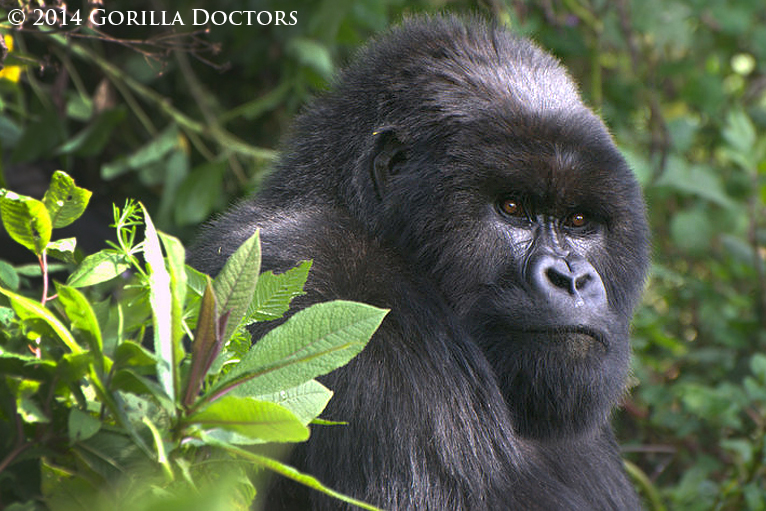 Young silverback Muturengere, the new leader of Isimbi group.
Young silverback Muturengere, the new leader of Isimbi group.
For example, there’s elderly female Poppy, who has been showing clear signs that she is not keen on the young silverback leading the group. Poppy and her infant Inyungura have been traveling and resting on the outskirts of the group and disappeared entirely from the group for 2 days, indicating she may be eager to emigrate out. We hope this does not come to pass, as her young infant would be at risk of infanticide by another silverback.
Born on April 1, 1976, Poppy is one of the oldest mountain gorillas in the park and one of only 4 gorillas alive today that Dian Fossey studied. Interestingly, Poppy is the mother of Isonga, the lone silverback who has been trailing Isimbi group of late. Isonga’s close proximity has posed a threat to the fragile bonds of Isimbi group under Muturengere’s leadership.
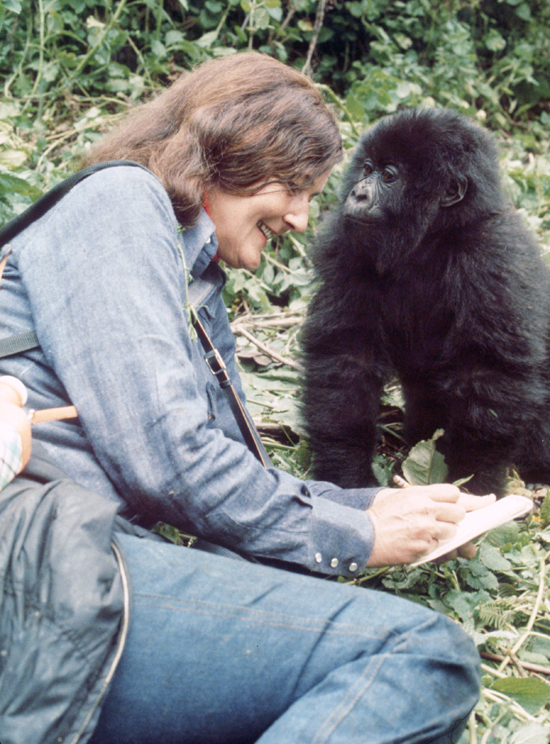 Beautiful photo by Ian Redmond of Dian Fossey with Poppy, as an infant.
Beautiful photo by Ian Redmond of Dian Fossey with Poppy, as an infant.
With the stress of holding onto his group members and lone silverback Isonga following their trail for days, Muturengere was very susceptible to illness. In mid-December, he began exhibiting mild symptoms of a respiratory infection and his condition has gradually worsened.
Early morning on Sunday January 12, Drs. Jean Felix and Noel, along with RDB Veterinary Warden Elisabeth Nyirakaragire and a team of RDB trackers trekked to Isimbi group, prepared to assess Muturengere’s condition and intervene with medications if necessary. Filmmaker Michael Boland, who is working on a documentary for CBC’s The Nature of Things, joined the group to document the effort.
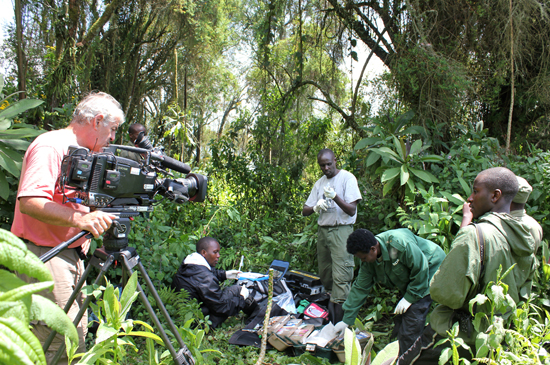 Filmmaker Michael Boland documents the intervention team making preparations.
Filmmaker Michael Boland documents the intervention team making preparations.
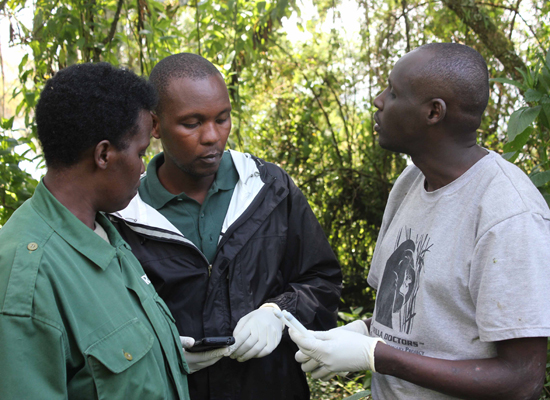 Elisabeth and Drs. Noel and Jean Felix calculate the medication dosages and prepare the darts before reaching the group.
Elisabeth and Drs. Noel and Jean Felix calculate the medication dosages and prepare the darts before reaching the group.
The team of veterinarians observed Muturengere for one hour before making the decision to intervene. A full veterinary intervention, where Muturengere would be anesthetized for examination and sample collection, is not a viable option at this point. With the group hanging in the balance as it is, anesthetizing their leader could provide the ideal opportunity for the females to disperse.
“Muturengere was coughing frequently, holding his sides as he coughed indicating he may have been in some pain” said Dr. Jean Felix. “He fed very little during my observation, was very lethargic, with nasal discharge and a high respiratory rate.”
The decision was made for Dr. Jean Felix and Dr. Noel to dart Muturengere simultaneously with Ceftriaxone and Ketoprofene (antibiotics and anti-inflammatory medications). After waiting for the opportune time to dart, Drs. Jean Felix and Noel successfully administered the medications. Muturengere immediately charged the field team, grabbing the leg of tracker Kavamahanga. The team quickly made appeasement vocalizations and brandished large sticks to deter him, and the silverback moved away, coming to a stop approximately 30 meters from the team. “After some time, he calmed down and began to feed, but continued to eye us warily” said Dr. Jean Felix.
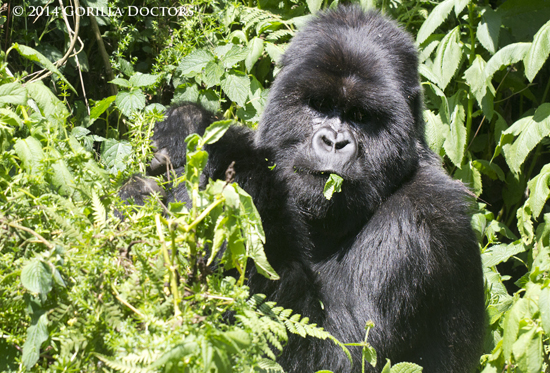 Muturengere, feeding after the intervention.
Muturengere, feeding after the intervention.
A respiratory infection can spread through a mountain gorilla group like wildlife leaving many individuals seriously ill. If the symptoms don’t resolve, a medical intervention becomes necessary to prevent the spread and severity of the illness. After death by trauma (including infanticide and fatal injuries caused by accidents or violence), infectious disease is the leading cause of death in mountain gorillas, accounting for more than 20% of mortality. The most common infectious disease? Respiratory disease.
In March 2011, the CDC Journal of Emerging Infectious Disease published a study by the Mountain Gorilla Veterinary Project (MGVP); the Wildlife Health Center at the University of California, Davis; the Center for Infection and Immunity at Columbia University; and the Rwanda Development Board linking a human respiratory virus to the deaths of two mountain gorillas, an adult female and an infant, in Volcanoes National Park’s Hirwa group. To read more about this study, click here.
Muturengere will continue to be monitored closely to ensure a full recovery.
You can follow the Gorilla Doctors health monitoring efforts on our Facebook page, where we post photos and notes from our monthly visits.
Please consider supporting us by making a secure online donation. Every dollar you give goes to directly supporting our gorilla health programs and One Health initiative. Thank you for your generosity.


 Donate
Donate